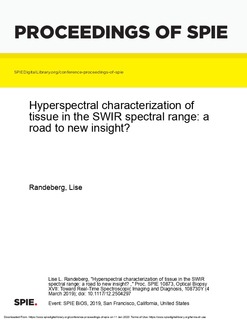Hyperspectral characterization of tissue in the SWIR spectral range: a road to new insight?
Journal article, Peer reviewed
Published version

Åpne
Permanent lenke
http://hdl.handle.net/11250/2635982Utgivelsesdato
2019Metadata
Vis full innførselSamlinger
Originalversjon
Proceedings of SPIE, the International Society for Optical Engineering. 2019, 10873 . 10.1117/12.2504297Sammendrag
Hyperspectral imaging is a generic imaging modality allowing high spectral and spatial resolution over a wide wavelength range from the visible to mid-infrared. Short wavelength infrared (SWIR) hyperspectral imaging is currently becoming an important supplement to spectroscopy in optical diagnostics due to the flexibility and adaptability of the technique. However, due to the complexity of hyperspectral data, the analysis requires a well planned approach. In this paper a simple but effective approach combining dimension reduction and unsupervised classification is suggested. Examples of in vivo hyperspectral data in the SWIR spectral range (950-2500 nm) from human skin bruises and porcine skin burns are presented as examples. Data are processed using the minimum noise fraction transform (MNF), and K-means clustering. K-means clustering was found to perform significantly better if applied to MNF transformed data. The classification results agree well with biopsies, spectral data and visual inspection of injuries. It is thus shown that unsupervised clustering can be a preferable technique in cases where it is challenging to use or interpret results from physics based models, or where the ground truth is lacking or not well defined. The presented results confirm that SWIR hyperspectral imaging indeed is a useful tool for optical characterization of tissue.